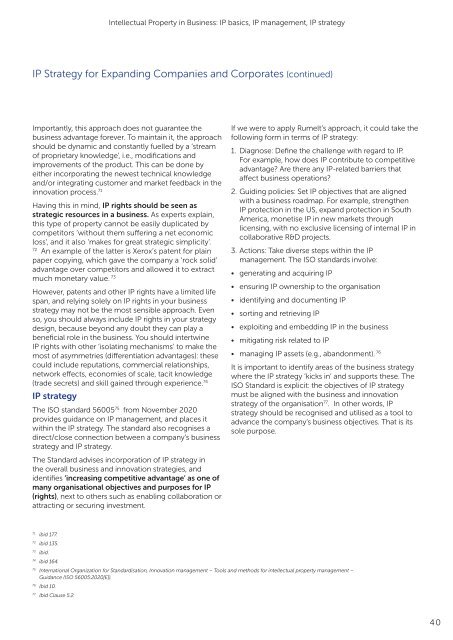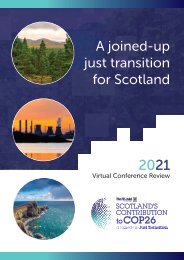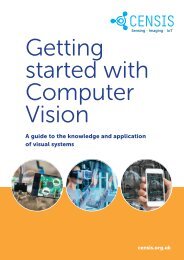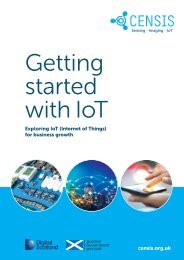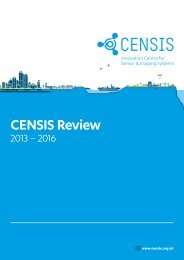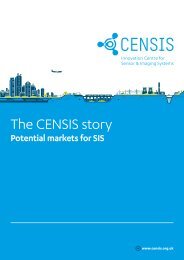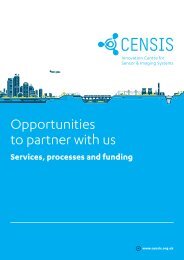CENSIS white paper: Intellectual Property in Business
2023: This CENSIS white paper sets out to make the topic of IP more approachable, less intimidating and more manageable, offering experience-based advice and methods are are designed to help businesses structure their IP- related issues and makes the best of their IP. Covering: The role of IP, IP management during growth, IP strategy for expanding companies and corporates, Business IP Canvas - merging IP with your business model.
2023: This CENSIS white paper sets out to make the topic of IP more approachable, less intimidating and more manageable, offering experience-based advice and methods are are designed to help businesses structure their IP- related issues and makes the best of their IP.
Covering:
The role of IP, IP management during growth, IP strategy for expanding companies and corporates, Business IP Canvas - merging IP with your business model.
You also want an ePaper? Increase the reach of your titles
YUMPU automatically turns print PDFs into web optimized ePapers that Google loves.
<strong>Intellectual</strong> <strong>Property</strong> <strong>in</strong> Bus<strong>in</strong>ess: IP basics, IP management, IP strategy<br />
IP Strategy for Expand<strong>in</strong>g Companies and Corporates (cont<strong>in</strong>ued)<br />
Importantly, this approach does not guarantee the<br />
bus<strong>in</strong>ess advantage forever. To ma<strong>in</strong>ta<strong>in</strong> it, the approach<br />
should be dynamic and constantly fuelled by a ‘stream<br />
of proprietary knowledge’, i.e., modifications and<br />
improvements of the product. This can be done by<br />
either <strong>in</strong>corporat<strong>in</strong>g the newest technical knowledge<br />
and/or <strong>in</strong>tegrat<strong>in</strong>g customer and market feedback <strong>in</strong> the<br />
<strong>in</strong>novation process. 71<br />
Hav<strong>in</strong>g this <strong>in</strong> m<strong>in</strong>d, IP rights should be seen as<br />
strategic resources <strong>in</strong> a bus<strong>in</strong>ess. As experts expla<strong>in</strong>,<br />
this type of property cannot be easily duplicated by<br />
competitors ‘without them suffer<strong>in</strong>g a net economic<br />
loss’, and it also ‘makes for great strategic simplicity’.<br />
72<br />
An example of the latter is Xerox’s patent for pla<strong>in</strong><br />
<strong>paper</strong> copy<strong>in</strong>g, which gave the company a ‘rock solid’<br />
advantage over competitors and allowed it to extract<br />
much monetary value. 73<br />
However, patents and other IP rights have a limited life<br />
span, and rely<strong>in</strong>g solely on IP rights <strong>in</strong> your bus<strong>in</strong>ess<br />
strategy may not be the most sensible approach. Even<br />
so, you should always <strong>in</strong>clude IP rights <strong>in</strong> your strategy<br />
design, because beyond any doubt they can play a<br />
beneficial role <strong>in</strong> the bus<strong>in</strong>ess. You should <strong>in</strong>tertw<strong>in</strong>e<br />
IP rights with other ‘isolat<strong>in</strong>g mechanisms’ to make the<br />
most of asymmetries (differentiation advantages): these<br />
could <strong>in</strong>clude reputations, commercial relationships,<br />
network effects, economies of scale, tacit knowledge<br />
(trade secrets) and skill ga<strong>in</strong>ed through experience. 74<br />
IP strategy<br />
The ISO standard 56005 75 from November 2020<br />
provides guidance on IP management, and places it<br />
with<strong>in</strong> the IP strategy. The standard also recognises a<br />
direct/close connection between a company’s bus<strong>in</strong>ess<br />
strategy and IP strategy.<br />
The Standard advises <strong>in</strong>corporation of IP strategy <strong>in</strong><br />
the overall bus<strong>in</strong>ess and <strong>in</strong>novation strategies, and<br />
identifies ‘<strong>in</strong>creas<strong>in</strong>g competitive advantage’ as one of<br />
many organisational objectives and purposes for IP<br />
(rights), next to others such as enabl<strong>in</strong>g collaboration or<br />
attract<strong>in</strong>g or secur<strong>in</strong>g <strong>in</strong>vestment.<br />
If we were to apply Rumelt’s approach, it could take the<br />
follow<strong>in</strong>g form <strong>in</strong> terms of IP strategy:<br />
1. Diagnose: Def<strong>in</strong>e the challenge with regard to IP.<br />
For example, how does IP contribute to competitive<br />
advantage? Are there any IP-related barriers that<br />
affect bus<strong>in</strong>ess operations?<br />
2. Guid<strong>in</strong>g policies: Set IP objectives that are aligned<br />
with a bus<strong>in</strong>ess roadmap. For example, strengthen<br />
IP protection <strong>in</strong> the US, expand protection <strong>in</strong> South<br />
America, monetise IP <strong>in</strong> new markets through<br />
licens<strong>in</strong>g, with no exclusive licens<strong>in</strong>g of <strong>in</strong>ternal IP <strong>in</strong><br />
collaborative R&D projects.<br />
3. Actions: Take diverse steps with<strong>in</strong> the IP<br />
management. The ISO standards <strong>in</strong>volve:<br />
• generat<strong>in</strong>g and acquir<strong>in</strong>g IP<br />
• ensur<strong>in</strong>g IP ownership to the organisation<br />
• identify<strong>in</strong>g and document<strong>in</strong>g IP<br />
• sort<strong>in</strong>g and retriev<strong>in</strong>g IP<br />
• exploit<strong>in</strong>g and embedd<strong>in</strong>g IP <strong>in</strong> the bus<strong>in</strong>ess<br />
• mitigat<strong>in</strong>g risk related to IP<br />
• manag<strong>in</strong>g IP assets (e.g., abandonment). 76<br />
It is important to identify areas of the bus<strong>in</strong>ess strategy<br />
where the IP strategy ‘kicks <strong>in</strong>’ and supports these. The<br />
ISO Standard is explicit: the objectives of IP strategy<br />
must be aligned with the bus<strong>in</strong>ess and <strong>in</strong>novation<br />
strategy of the organisation 77 . In other words, IP<br />
strategy should be recognised and utilised as a tool to<br />
advance the company’s bus<strong>in</strong>ess objectives. That is its<br />
sole purpose.<br />
71<br />
ibid 177.<br />
72<br />
ibid 135.<br />
73<br />
ibid.<br />
74<br />
ibid 164.<br />
75<br />
International Organization for Standardisation, Innovation management – Tools and methods for <strong>in</strong>tellectual property management –<br />
Guidance (ISO 56005:2020[E]).<br />
76<br />
Ibid 10.<br />
77<br />
Ibid Clause 5.2.<br />
40


